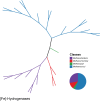Molecular Hydrogen, a Neglected Key Driver of Soil Biogeochemical Processes
- PMID: 30658976
- PMCID: PMC6414374
- DOI: 10.1128/AEM.02418-18
Molecular Hydrogen, a Neglected Key Driver of Soil Biogeochemical Processes
Abstract
The atmosphere of the early Earth is hypothesized to have been rich in reducing gases such as hydrogen (H2). H2 has been proposed as the first electron donor leading to ATP synthesis due to its ubiquity throughout the biosphere as well as its ability to easily diffuse through microbial cells and its low activation energy requirement. Even today, hydrogenase enzymes enabling the production and oxidation of H2 are found in thousands of genomes spanning the three domains of life across aquatic, terrestrial, and even host-associated ecosystems. Even though H2 has already been proposed as a universal growth and maintenance energy source, its potential contribution as a driver of biogeochemical cycles has received little attention. Here, we bridge this knowledge gap by providing an overview of the classification, distribution, and physiological role of hydrogenases. Distribution of these enzymes in various microbial functional groups and recent experimental evidence are finally integrated to support the hypothesis that H2-oxidizing microbes are keystone species driving C cycling along O2 concentration gradients found in H2-rich soil ecosystems. In conclusion, we suggest focusing on the metabolic flexibility of H2-oxidizing microbes by combining community-level and individual-level approaches aiming to decipher the impact of H2 on C cycling and the C-cycling potential of H2-oxidizing microbes, via both culture-dependent and culture-independent methods, to give us more insight into the role of H2 as a driver of biogeochemical processes.
Keywords: H2 oxidation; anaerobic processes; biogeochemical processes; carbon cycle; environmental microbiology; hydrogen; soil.
Copyright © 2019 American Society for Microbiology.
Figures




Similar articles
-
Genomic and metagenomic surveys of hydrogenase distribution indicate H2 is a widely utilised energy source for microbial growth and survival.ISME J. 2016 Mar;10(3):761-77. doi: 10.1038/ismej.2015.153. Epub 2015 Sep 25. ISME J. 2016. PMID: 26405831 Free PMC article.
-
The Tale of a Neglected Energy Source: Elevated Hydrogen Exposure Affects both Microbial Diversity and Function in Soil.Appl Environ Microbiol. 2017 May 17;83(11):e00275-17. doi: 10.1128/AEM.00275-17. Print 2017 Jun 1. Appl Environ Microbiol. 2017. PMID: 28363961 Free PMC article.
-
Analysis of [FeFe]-hydrogenase genes for the elucidation of a hydrogen-producing bacterial community in paddy field soil.FEMS Microbiol Lett. 2014 Jan;350(2):249-56. doi: 10.1111/1574-6968.12335. Epub 2013 Dec 11. FEMS Microbiol Lett. 2014. PMID: 24261851
-
Biogeochemistry of dihydrogen (H2).Met Ions Biol Syst. 2005;43:9-48. doi: 10.1201/9780824751999.ch2. Met Ions Biol Syst. 2005. PMID: 16370113 Review.
-
Atmospheric hydrogen scavenging: from enzymes to ecosystems.Appl Environ Microbiol. 2015 Feb;81(4):1190-9. doi: 10.1128/AEM.03364-14. Appl Environ Microbiol. 2015. PMID: 25501483 Free PMC article. Review.
Cited by
-
Soil Microbiomes With the Genetic Capacity for Atmospheric Chemosynthesis Are Widespread Across the Poles and Are Associated With Moisture, Carbon, and Nitrogen Limitation.Front Microbiol. 2020 Aug 12;11:1936. doi: 10.3389/fmicb.2020.01936. eCollection 2020. Front Microbiol. 2020. PMID: 32903524 Free PMC article.
-
Increasing power generation to a single-chamber compost soil urea fuel cell for carbon-neutral bioelectricity generation: A novel approach.Front Microbiol. 2023 Feb 17;14:1086962. doi: 10.3389/fmicb.2023.1086962. eCollection 2023. Front Microbiol. 2023. PMID: 36876058 Free PMC article.
-
Sensitivity of soil hydrogen uptake to natural and managed moisture dynamics in a semiarid urban ecosystem.PeerJ. 2022 Mar 17;10:e12966. doi: 10.7717/peerj.12966. eCollection 2022. PeerJ. 2022. PMID: 35317075 Free PMC article.
-
Organohalide respiration potential in marine sediments from Aarhus Bay.FEMS Microbiol Ecol. 2022 Jul 21;98(8):fiac073. doi: 10.1093/femsec/fiac073. FEMS Microbiol Ecol. 2022. PMID: 35689665 Free PMC article.
-
Carbon amendments in soil microcosms induce uneven response on H2 oxidation activity and microbial community composition.FEMS Microbiol Ecol. 2023 Nov 13;99(12):fiad159. doi: 10.1093/femsec/fiad159. FEMS Microbiol Ecol. 2023. PMID: 38040657 Free PMC article.
References
-
- Oparin AI. 1938. The origin of life. J Chem Educ 15:399. doi:10.1021/ed015p399.1. - DOI
Publication types
MeSH terms
Substances
LinkOut - more resources
Full Text Sources
Miscellaneous

